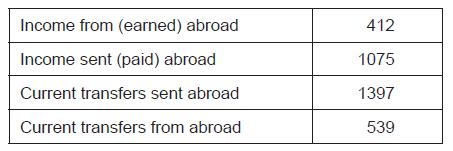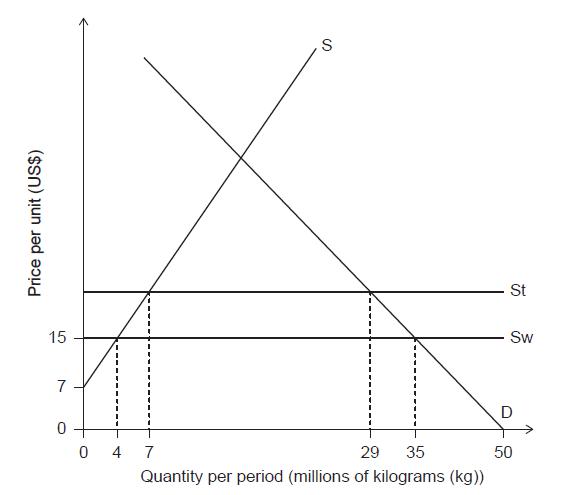
Topic 2 - Macroeconomics
Question 1
HLPaper 1Explain the potential effects on the economic growth rate from a substantial increase in the number of skilled people of working age entering a country.
Discuss the view that, apart from indicating economic growth rates over time, national income statistics are of little use.
Question 2
SLPaper 1Explain the various phases of the business cycle.
Discuss the view that economies will always return to the full employment level of output in the long run.
Question 3
HLPaper 3Table 5 shows selected items of the balance of payments for Laylaland in 2020. Figures are in millions of US dollars (US$).
Table 5

Laylaland has a current account deficit of US$1865 million.
Chia seeds are an agricultural good produced in many countries and priced in US dollars (US$).
Figure 1 illustrates the market for chia seeds in a small country called Nofiberland. D is the domestic demand and S is the domestic supply for chia seeds. Chia seeds can be initially imported at the current world price of US$15.00 per kg. Sw is therefore the world supply faced in Nofiberland with free trade. To protect Nofiberland producers, the government decides to impose a US$6.00 tariff on chia seed imports. St is therefore the world supply faced in Nofiberland after the tariff is imposed.
Figure 1

Quinoa is a great source of protein and is thus considered a “super food”. As a result, the demand for quinoa in advanced economies has lately been rising very fast while global supply has not changed. A small country called Proteinland gets 80 % of its export revenues from exporting quinoa to advanced economies.
Distinguish between credit and debit items in the balance of payments.
State one example of a debit item from the financial account of the balance of payments.
Using Table 5, calculate the value of net current transfers for Laylaland in 2020.
Using Table 5, calculate the net exports of goods and services for Laylaland in 2020.
Explain two methods that Laylaland’s government could use to correct the current account deficit.
List two administrative barriers that Nofiberland could have used to limit imports of chia seeds.
Calculate the price elasticity of demand for chia seeds in Nofiberland following the imposition of the tariff.
Calculate the change in consumer expenditure on imported chia seeds in Nofiberland resulting from the imposition of the tariff.
Calculate the total welfare loss resulting from the imposition of the tariff on chia seeds.
Outline one reason why the imposition of the tariff would lead to a welfare loss.
Describe the impact of the rise in demand for quinoa on the terms of trade of Proteinland.
Explain how the increase in world demand for quinoa would likely affect the current account balance of Proteinland.
Question 4
HLPaper 1Explain how equilibrium interest rates are determined in an economy.
Discuss whether an increase in interest rates is the most effective way of reducing the rate of inflation in an economy.
Question 5
HLPaper 1Explain the possible impact of an increase in wealth and consumer confidence on aggregate demand.
Examine why, in contrast to the monetarist/new classical model, the economy will not automatically return to the full employment level of output in the Keynesian model.
Question 6
SLPaper 2Japan–European Union Economic Partnership Agreement (JEEPA)
-
In July 2017, the Japan–European Union Economic Partnership Agreement (JEEPA) was announced and it may come into force in 2019. Jointly, Japan and the European Union (EU) currently account for 28 % of global gross domestic product (GDP). The trade agreement could raise the EU’s exports to Japan by 34 % and Japan’s exports to the EU by 29 %. Economists say that this trade agreement marks a determined effort to combat rising protectionism and sends a powerful signal that cooperation, not trade protection, is the way to tackle global challenges.
-
The largest benefit to Japan will be for Japanese car manufacturers, as Europe will gradually lower tariffs from 10 % on Japanese cars. Car tariffs are a big concern for Japanese car manufacturers, who struggle to compete with South Korean car manufacturers. South Korean cars are sold to the EU tariff-free thanks to a free trade agreement signed in 2011. Within Europe, car manufacturers are one of the largest sources of jobs. Car manufacturers in the EU are concerned that cutting tariffs on car imports from Japan may lead to a large increase of Japanese cars into the European market.
-
The trade agreement will also resolve non-tariff barriers, such as technical requirements and regulations. More importantly, however, the EU and Japan will make their environmental and safety standards on cars the same, which will make trade easier.
-
Japanese politicians have been defending their relatively inefficient farmers for a long time. Now, Japan will lower tariffs on European meat, dairy products and wine, cutting 85 % of the tariffs on food products coming into Japan. This includes removing the current 30 % tariff on some European cheeses, such as cheddar and gouda cheese. However, imported camembert cheese will face a quota. This may be because Japan produces some camembert cheese.
-
JEEPA is particularly alarming for United States (US) beef and pork farmers because Japan has been the biggest export market for US beef and the second biggest export market for US pork. Any preferential tariff that EU farmers receive will make it much tougher for American farmers to sell meat in Japan.
-
With this trade agreement, the EU and Japan are trying to promote the values of economic cooperation and environmental conservation, which are both important for long-term economic growth and sustainability. However, JEEPA faces significant challenges because it will have to be passed by the Japanese Parliament, the European Parliament and European national governments. There is no guarantee that all governments will agree to the economic partnership.
[Source: adapted from The Japan-EU Trade Agreement: Pushing Back Against Protectionism, http://globalriskinsights.com,
15 July 2017; Japan-EU trade agreement may hurt U.S. meat producers, by Katherine Hyunjung Lee, Jul 12, 2017, Medill
News Service, https://dc.medill.northwestern.edu; and A new trade deal between the EU and Japan, The Economist (London,
England), Jul 8th 2017, https://www.economist.com/finance-and-economics/2017/07/08/a-new-trade-deal-between-the-eu-andjapan.
© The Economist Newspaper Limited, London, July 8th 2017]
Define the term quota indicated in bold in the text (paragraph [4]).
Define the term sustainability indicated in bold in the text (paragraph [6]).
Using an AD/AS diagram, explain the impact of the trade agreement between Japan and the EU (JEEPA) on Japan’s economic growth (paragraph [1]).
Using an international trade diagram, explain the likely impact of Japan “removing the current 30 % tariff” on the level of cheddar cheese imports. (paragraph [4]).
Using information from the text/data and your knowledge of economics, evaluate the possible consequences of the trade agreement between Japan and the EU (JEEPA).
Question 7
SLPaper 2Pakistan and the International Monetary Fund
-
Pakistan is a low-income country with a rapidly growing population and widespread poverty. As of 2019, it has a large budget deficit due to high levels of military spending and high costs of debt servicing (35 % of the deficit is interest payments). It is also experiencing a widening current account deficit and is heavily dependent on foreign aid.
-
Pakistan’s government is negotiating a loan from the International Monetary Fund (IMF). Amongst its conditions, the IMF has said that the government must decrease private-sector regulation such as regulations on financial institutions. The government must also sell state-owned enterprises and government revenue must be raised by increasing indirect taxes and improving tax collection systems. Furthermore, the IMF insists that the government cuts its spending further.
-
The government has stated that the IMF loan is essential to restore confidence in Pakistan’s economy. This would help to attract foreign direct investment (FDI) to encourage economic growth and help break out of the poverty cycle. High debt levels and slowing economic growth in 2018 discouraged FDI. The IMF loan is also needed to help persuade other multilateral lenders such as the World Bank and the Asian Development Bank to provide and extend loans.
-
In the past, Pakistan has had 21 agreements with the IMF with limited success—any balance of payments or external debt improvement has been temporary. The IMF states that this is because Pakistan has not always met the conditions of the loans, while other stakeholders argue it was the lack of support given to Pakistan to implement the conditions and to allocate the loan funds appropriately.
-
Economists say that there needs to be a focus on improving human capital to provide the large number of young people entering the labour force with the skills to grow businesses. The quality of education needs to improve and to be combined with an effort to provide girls with greater access to education—female participation in the labour force is the lowest in the region.
-
The World Bank has financed education and infrastructure, such as renewable energy projects, in poor regions of Pakistan. However, critics of the World Bank argue that the projects are not making a significant difference and the construction of hydroelectric dams leads to environmental damage.
-
The government believes that the macroeconomic concerns of the IMF should be addressed first, and poverty issues in Pakistan can be dealt with later.
[Source: © International Baccalaureate Organization 2020.]
State two functions of the International Monetary Fund (IMF) (paragraph [2]).
Define the term human capital indicated in bold in the text (paragraph [5]).
Using a poverty cycle diagram, explain how the government of Pakistan could intervene to “break out of the poverty cycle” (paragraph [3]).
Using an externalities diagram, explain how “greater access to education” for girls in Pakistan could reduce market failure (paragraph [5]).
Using information from the text/data and your knowledge of economics, evaluate the potential impact of the IMF and the World Bank on economic development in Pakistan.
Question 8
SLPaper 2New Zealand dollar overvalued
-
The New Zealand finance minister said the exchange rate of the New Zealand dollar (NZD), is “unsustainably high; it is somewhere between 10 % to 15 % overvalued”.
-
The NZD had been near its record high against the US dollar before weakening last week on slower inflation figures and a fall in dairy prices. The NZD has gained about 6 % so far this year.
-
However, the finance minister said that New Zealand exporters had developed strength because of the high currency. “New Zealand is actually in reasonably good shape,” he said. “We have had an export sector operating with a strong exchange rate now for five or six years and that has had an impact on efficiency.”
-
An economist said recently that the central bank might consider intervening in the currency market to achieve a depreciation in the value of the NZD.
-
The Reserve Bank (central bank) governor raised the official interest rate for the fourth time this year to 3.5 % at a time when other major economies have their rates at record low levels.
-
He said that, “Encouragingly, the economy appears to be adjusting to the monetary policy tightening that has taken place since the start of the year. It is important that inflation expectations remain contained. This interest rate increase will help keep future average inflation near the 2 % target and ensure that the economic expansion can be sustained”.
-
New Zealand’s economy is expected to grow at an annual pace of 3.7 % over 2014. New Zealand government figures showed a monthly trade (in goods) surplus of 371 million in June 2013. The annual trade (in goods) balance turned to a surplus of 819 million a year earlier.
-
Global demand for New Zealand dairy products has been a key support for the country’s exports over the past 18 months, though prices have dropped this year with increased supply.

Define the term depreciation indicated in bold in the text (paragraph[4]).
Define the term monetary policy indicated in bold in the text(paragraph[6]).
Using an exchange rate diagram, explain how the increase in the official interest rate to 3.5 % is likely to affect the value of the New Zealand dollar (paragraph[5]).
Using an AD/AS diagram, explain how “monetary policy tightening” may affect a country’s inflation rate (paragraph[6]).
Using information from the text/data and your knowledge of economics, discuss the possible economic consequences of an overvalued New Zealand dollar on the New Zealand economy.
Question 9
HLPaper 1Explain how the Lorenz curve and the Gini coefficient are used to measure differences in income inequality between countries.
Discuss the view that taxation is the most effective means of achieving equity in the distribution of income.
Question 10
HLPaper 1Explain why a high rate of inflation may negatively affect both a country’s export competitiveness and the level of capital investment by firms.
Discuss the view that the use of monetary policy is always the best way to reduce inflation.
